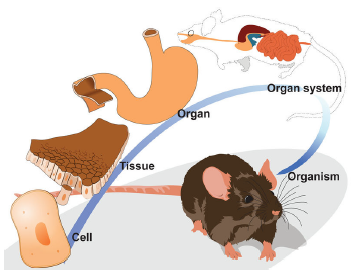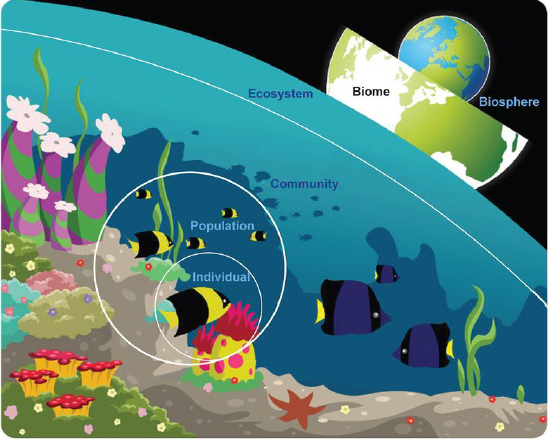Reading: The Organization of Life
Douglas Wilkin, Ph.D.
Jean Brainard, Ph.D.
http://www.ck12.org/saythanks
• Define cell.
• Define biodiversity.
• Describe the organization of organisms.
• Summarize the levels of organization in an ecosystem.
Organization of Living Things. What does this mean?
We know it all starts with the cell. And for some species it ends with the cell. But for others, the cells come together to form tissues, tissues form organs, organs form organ systems, and organ systems combine to form an organism.
Levels of Organization
The living world can be organized into different levels. For example, many individual organisms can be organized into the following levels:
• Cell: Basic unit of structure and function of all living things.
• Tissue: Group of cells of the same kind.
• Organ: Structure composed of one or more types of tissues. The tissues of an organ work
together to perfume a specific function.
• Organ system: Group of organs that work together to perform a certain function.
• Organism: Individual living thing that may be made up of one or more organ systems.

FIGURE 1.1
An individual mouse is made up of several organ systems. The system shown here is the digestive system, which breaks down food into a form that cells can use. One of the organs of the digestive system is the stomach. The stomach, in turn, consists of different types of tissues. Each type of tissue is made up of cells of the same type.
There are also levels of organization above the individual organism.
• Organisms of the same species that live in the same area make up a population. For example,
all of the goldfish living in the same area make up a goldfish population.
• All of the populations that live in the same area make up a community. The community that
includes the goldfish population also includes the populations of other fish, coral, and other
organisms.
• An ecosystem consists of all the living things in a given area, together with the nonliving
environment. The nonliving environment includes water, sunlight, and other physical factors.
• A group of similar ecosystems with the same general type of physical environment is called a
biome.
• The biosphere is the part of Earth where all life exists, including all the land, water, and air where
living things can be found. The biosphere consists of many different biomes.
Diversity of Life
Life on Earth is very diverse. The diversity of living things is called biodiversity. A measure of Earth’s biodiversity is the number of different species of organisms that live on Earth. At least 10 million different species live on Earth today. They are commonly grouped into six different kingdoms.
Summary
• Many individual organisms can be organized into the following levels: cells, tissues, organs, and organs systems.
• An ecosystem consists of all the populations in a given area, together with the nonliving environment.
• The biosphere is the part of Earth where all life exists.
• The diversity of living things is called biodiversity.

FIGURE 1.2
This picture shows the levels of organization in nature, from the individual organism to the biosphere.
Review
1. Describe the levels of organization of a complex, multicellular organism such as a mouse, starting with the cell.
2. Explain how a population differs from a community.
3. What is an ecosystem?
4. Give three examples of the nonliving environment.
5. What is biodiversity?
